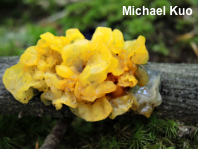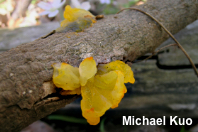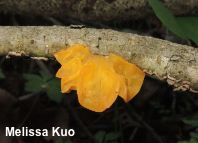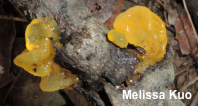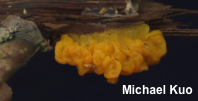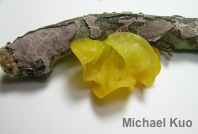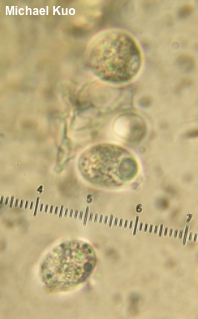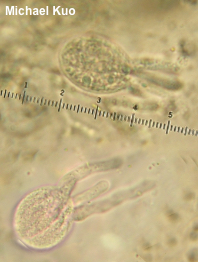| Major Groups > Jelly Fungi > Tremella mesenterica |

|
Tremella mesenterica [ Basidiomycota > Tremellales > Tremellaceae > Tremella ... ] by Michael Kuo This common jelly fungus appears on the deadwood of hardwoods—usually on sticks 0.5–1.5 inches in diameter, with the bark still attached, in my collecting experience. As it is currently defined the species is found across North America, in Europe, and elsewhere. Sometimes called "witch's butter," Tremella mesenterica appears as a yellow mass of brain-like lobes with a gelatinous consistency. Although the species appears to be growing on wood, it is actually a parasite on the (usually hidden) mycelium of a crust fungus in the genus Peniophora—and this fact is useful in separating Tremella mesenterica from a look-alike, Tremella aurantia, which parasitizes Stereum hirsutum, often growing directly from the Stereum fruiting bodies. The Peniophora species being attacked by Tremella mesenterica are harder to locate, but can sometimes be found on the lower surface of the stick, beneath the Tremella (enlarge the third and sixth illustrations to the right). Microscopic differences also separate Tremella mesenterica from look-alikes. Tremella aurantia features smaller spores and basidia, and never features conidia; species of Dacrymyces, which can look to the naked eye very much like yellow Tremella species, feature very different basidia (Y-shaped) and spores (septate and allantoid) under the microscope. Description: Ecology: Parasitic on the mycelium of species of Peniophora (a genus of crust fungi); growing alone or in amorphous clusters on the decaying sticks and logs of oaks and other hardwoods (usually when bark is still adnate); usually appearing in spring, in temperate areas, but also appearing in summer, fall, and winter; widely distributed in North America, but possibly less common in western North America. The illustrated and described collections are from Illinois and Indiana. Fruiting Body: A mass of lobes or brainlike sections 2–5 cm across and 1–3 cm high; surface bald, moist, dull to bright yellow or orangish yellow; flesh gelatinous, yellow; fading and sometimes becoming amorphous and poorly defined with old age or in wet conditions; drying to an orangish yellow crust. Odor and Taste: Not distinctive. Microscopic Features: Spores 10–15 x 6–12 µm; ellipsoid; smooth; hyaline in KOH; often "budding" to germinate by repetition, and then sometimes enlarging and/or becoming irregularly shaped. Basidia 21–22 x 12–18 µm; ellipsoid; mostly 4-sterigmate, with long, fingerlike sterigmata (to about 40 µm long); longitudinally septate. Conidia often present; variously sized but usually smaller than spores; ellipsoid to subfusiform; smooth; hyaline in KOH. REFERENCES: Retzius, 1769. (Saccardo, 1888; Atkinson, 1900; Lowy, 1971; Wong & Wells, 1985; Arora, 1986; Lincoff, 1992; Metzler & Metzler, 1992; Horn, Kay & Abel, 1993; Zugmaier et al., 1994; Roberts, 1995; Bandoni & Ginns, 1998; Chen, 1998; Barron, 1999; Roody, 2003; McNeil, 2006; Miller & Miller, 2006; Binion et al., 2008; Kuo & Methven, 2014; Overall, 2017; Woehrel & Light, 2017; Elliott & Stephenson, 2018.) Herb. Kuo 04179501, 04100901, 04220901, 05061301, 05011604, 05081602, 05261701, 06101801. This site contains no information about the edibility or toxicity of mushrooms. |
© MushroomExpert.Com |
|
Cite this page as: Kuo, M. (2018, October). Tremella mesenterica. Retrieved from the MushroomExpert.Com Web site: http://www.mushroomexpert.com/tremella_mesenterica.html |
